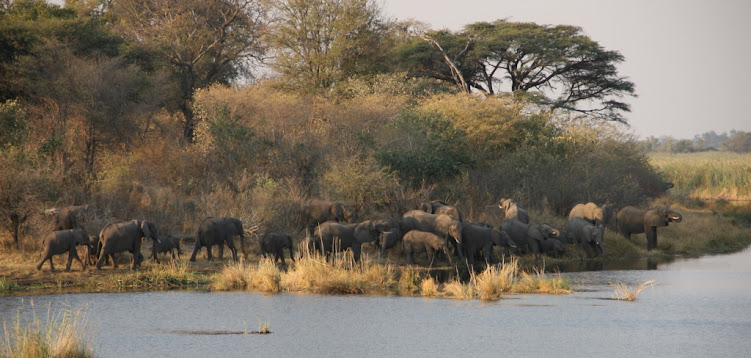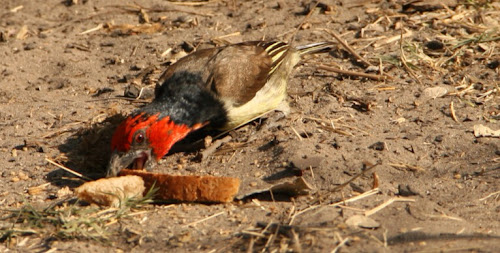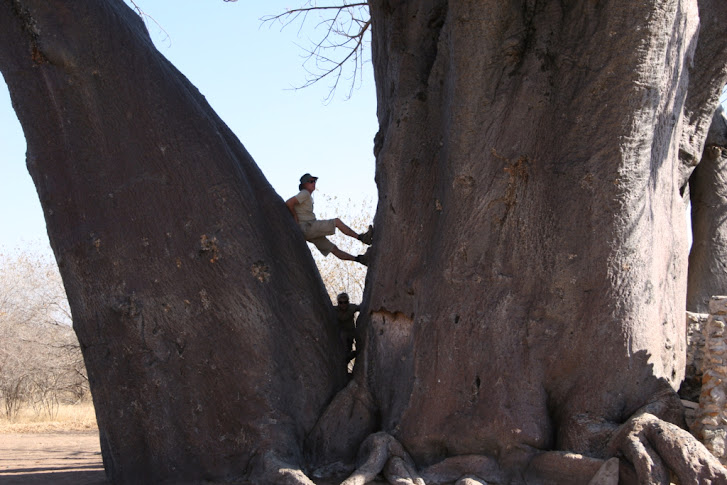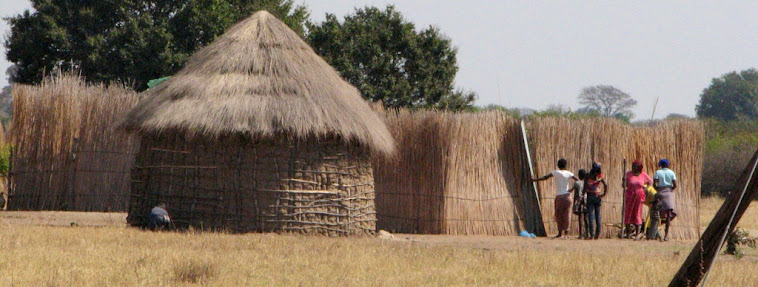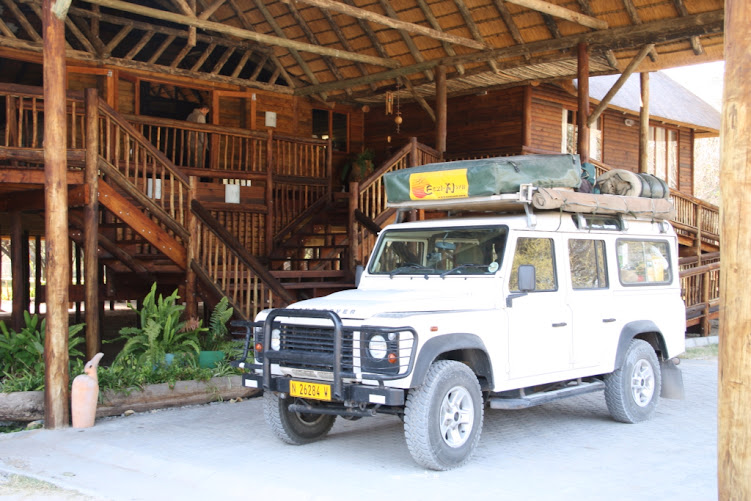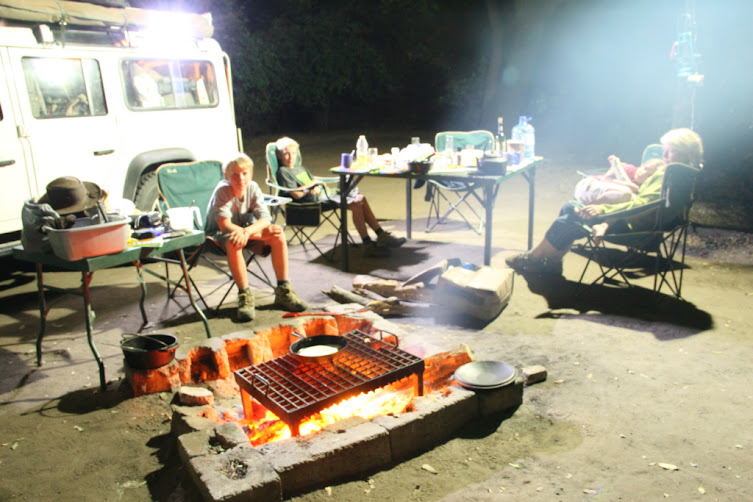Back on the main road, we make it to the Nambwa turn, which appears to be an exceptionally deep sand track, just before the road bridge, probably on a par with the sand track to the dunes of Sosussvlei and we have to travel 14km through this sand to get to our camp. The Land Rover tackles it fairly comfortably, provided you keep the momentum up and avoid tipping it, but on the down side, the difficulty in this deep sand is coming round the corner and being face to face with a heard of elephants!! ............ Getting stuck in the sand when faced with an angry elephant is not a good situation to get yourself in! ............ and I am not entirely sure how successful a fast getaway in deep sand, in reverse, would be!! ............. So deep concentration was required by the children with all eyes focused on the 'bush' ahead and any sign of large 'grey' movement!
We come across a large heard of elephants on the way in and many more elephants on the route to the camp, but fortunately we avoid any incidences of 'elephant road rage' and make it one piece, although I am sure Imogen would have resolved any such incidences with equalled ferocity and put them firmly in their place! Once at Camp, Duane, from Safari Drive, had informed us that when we arrive, try to take pitch 5 or 6, as they offer better pitches directly onto the river. As there were only 6 pitches and pitch 6 was already taken, we set up camp on pitch 5, which was extremely pleasant and right on the waters edge, literally within metres of the river, ................ that is the river which is home to many crocodiles, snakes and hippos, as well as the odd wandering heard of elephants that frequent the camp!! ..... so, ........ should be an interesting night!! ....... and in the routine we were becoming accustomed to, we pitch the tents, get the fire going and eat well before turning in for bed.
Jo and I are awake for some time as there are plenty of animal noises going on outside the tent, especially from 'snorting' Hippos! preparing to come out and graze. ............ (an adult Hippo will consume in excess of 45.5kg/100lbs of grass per night! ...... every night!) .... and we got the strange feeling that our little patch of grass in front of the tent was frequently 'mowed'. We were not disappointed! ...... at about 3.15am, I awoke to a loud surge and splash of water next to the tent, as this huge creature made his way to 'supper', followed by the extraordinary sound of large fat Hippo lips 'munching' grass. It was our grazing hippo!! .............. and on the basis he needed to consume some 45kg of grass per night ........ he was likely to be mowing right up to the tent door! ...... had it not been for the small area of sand in front of the tent to keep him at bay!! I quietly woke Jo and unzipped, very slowly ............... (sounds like a 'trashy' novel!) ......... the inside window cover in the tent; the bright light of the moon revealing the silhouetted black figure of a huge grazing hippo, approximately 4 metres from our exceptionally thin tent wall. ................... an awesome site!!! ..... Luckily the hippo was unable to tell the difference between a 'straw' house a 'tent' or a 'brick' house, so provided we remained very quite and still, we should be safe!!
The next morning we awake to the warmth and brightness of the sun bursting through the door of the tent as we lie and looked out over the river, a very peaceful scene ........ and not a Hippo in sight!
We enjoy a leisurely breakfast, watched very closely by an increasing array of colourful birds, from hornbills to crimson breasted shrikes to striped robin chats as well as squirrels and macaque monkeys, all hoping to join us, or at least get the leftovers.
Late morning we head out to 'Horseshoe Water' on our own game drive and see plenty of Kudu, Elephant and Impala, but the driving is quite difficult through deep sand, although the children are excited about helping out at the wheel!
A huge heard of Elephants are just leaving the river and cross ahead of us on the track, back into the bush and we stop to have a chat with a couple of Safari vehicles that have been watching them. One of the guides suggests a route for us to take, left at the fork ahead then take every right turn from there to get us back towards Camp and hopefully bump into a heard of some several hundred buffalo along the way. .......... well it sounded straight forward!!
However, one of the right turns was a very small track in the sand that cut back on itself and was very easy to miss, which we did! ............................. and after several miles through the bush we were soon 'running' the military border between Botswana and Namibia, informed by a very crude painted sign, where the Botswana Military (as we found out later) ran the border control with a 'shoot to kill' policy for suspected poachers!!
| A CRUDE SIGN IDENTIFYING THE BORDER |
| A MILITARY WARNING SIGN |
The Military Border Track appeared to be a possible way out ......... in Jo's mind, as navigator, ......... although Fred was now voicing fairly insistent pleas of: "Mum, I really think we should turn back!!" ............ I was keeping a relaxed, although quietly concerned, open mind about the situation although my concerns were growing as it became clear that the width of my Land Rover tracks were no match for the huge size of 'Army' vehicle that had clearly previously come down this route. After several kilometres of an unusually very straight and deep sandy track, I decided a swift 'U' turn was the order of the day, much to Fred's delight, before we possibly started hearing the close range whistle of bullets flying by!!
On the plus side, the wildlife we managed to stumble across was magnificent and clearly another tell tale sign that humans in Land Rovers were not regular visitors to this neck of the woods!! At one stage we came across six Sable, standing very majestically with an air of disdain that we dared to enter their territory, with their huge curved horns arched across the thick black fur of their backs. As they started to run the dust created an almost purposeful camouflage against the setting sun allowing them to disappear as if by magic. These are truly magnificent creatures. We also come across Roan, warthogs, baboons, elephants and a one eared giraffe!! ............... a successful day ............. that could have been very different!!
| SABLE DISAPPEARING IN THE DUST |
All in all Nambwa was a great camp, with the added luxury of an ablution block and after our border running adventure, Jo later found out that two local Namibian fisherman had been shot only last week!
